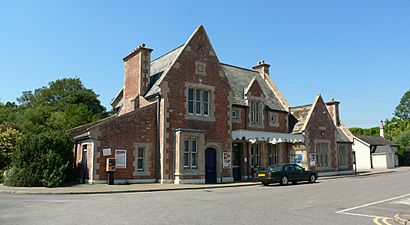Axminster railway station facts for kids
Quick facts for kids
|
|
|---|---|
 |
|
| Location | Axminster, East Devon England |
| Coordinates | 50°46′44″N 3°00′18″W / 50.779°N 3.005°W |
| Platforms | 2 |
| Other information | |
| Station code | AXM |
| Classification | DfT category D |
| History | |
| Original company | London and South Western Railway |
| Post-grouping | Southern Railway |
| Key dates | |
| 1860 | Opened |
| 1903 | Lyme Regis branch opened |
| 1965 | Lyme Regis branch closed |
| 1967 | Line singled |
| 2009 | Second platform reopened |
| Traffic | |
| Passengers (2015/16) | |
| Passengers (2016/17) | |
| Passengers (2017/18) | |
| Passengers (2018/19) | |
| Passengers (2019/20) | |
Axminster railway station is a train station in Axminster, Devon, England. It is located just outside the town centre. The station first opened in 1860. It was built by the London and South Western Railway (LSWR). Today, South Western Railway trains use it. These trains travel between London and Exeter on the West of England Main Line. The station is about 232 kilometers (144 miles) from London Waterloo.
Contents
History of Axminster Station
Axminster station opened on July 19, 1860. It was part of the LSWR's new line to Exeter Queen Street. This line connected from Yeovil Junction.
Early Days and New Lines
The main offices and a goods shed were on the east side of the tracks. A small engine shed was also built. It housed a locomotive to help trains climb the steep hill towards Honiton. A signal box was added in 1875.
Trains usually ran express services between London Waterloo and places in Devon or Cornwall. There were also local trains between Salisbury or Yeovil and Exeter. In 1903, Axminster became a railway junction. This happened when the Lyme Regis branch line opened. A new platform was built for this branch line. The branch line also had a steep climb. It crossed the main line south of the station using a bridge. The old engine shed was removed to make space for the new branch. A new coal stage and water tank were built near the new platform. The signal box was made bigger in 1903 to manage the new line.
Changes Over the Years
In 1923, the LSWR became part of the Southern Railway. This was due to a big change in British railways called the Grouping. The platforms were made longer in the 1930s. This allowed for longer trains to stop at the station. A new factory, Axminster Carpets, opened next to the goods yard in 1937. They made famous Axminster carpets.
On January 1, 1948, the Southern Railway was taken over by the government. It became part of British Railways. In January 1963, all lines in the area moved to the Western Region. Soon after, a report called Reshaping of British Railways suggested closing many lines.
On November 29, 1965, the Lyme Regis branch line was closed. Goods trains had already stopped using it in 1960. On June 11, 1967, the main line was simplified. Axminster was then in the middle of a single-track section. This section was about 24.5 kilometers (15.26 miles) long.
Modern Upgrades
In the late 1980s, the line became part of British Rail’s Network SouthEast. They invested in new Class 159 trains. The platform was also extended southwards. This made it easier for passengers to get to the trains. In the 1990s, British Rail was privatised. The line and station were then managed by South West Trains.
In February 2009, a big project started. It cost £20 million. This project included building a new platform where an old one used to be. A new footbridge, lifts, and waiting shelter were also added. Seven bridges and 20 culverts (tunnels for water) were made stronger. Twelve new signals were installed. Three miles of signal cables were replaced. The signalling panel at Chard Junction signal box was updated. This project finished in December 2009. It created a 3-kilometer (3-mile) passing loop at the station. This meant trains could pass each other at Axminster. This change allowed for a regular hourly train service.
The small building at the end of the main platform reopened as a café in 2009. Since December 2012, a company called Rail Gourmet UK has had a service centre here. Staff based at Axminster provide at-seat catering on many morning trains to Waterloo.
About Axminster Station
The station building was designed by Sir William Tite and Edward Clifton. It has a mock gothic style. Next to the main building, an old parcels office now holds the café. Just south of the main building is the footbridge built in 2009. This bridge connects the two platforms. Until late 2012, trains at Axminster unusually ran on the right track. Now, they run on the left, like most trains in the UK.
Train Services
South Western Railway runs hourly trains. These trains travel between London Waterloo and Exeter St Davids. Great Western Railway also has a service. Their trains run between Exeter St Davids and London Paddington. One of these trains stops at Axminster.
From Monday to Saturday, an early morning train to Exeter starts here. On weekdays, one late afternoon train from Exeter ends its journey at Axminster.
| Preceding station | Following station | |||
|---|---|---|---|---|
| Crewkerne | South Western Railway West of England Main Line |
Honiton | ||
| Historical railways | ||||
| Chard Junction Line open, station closed |
British Rail Western Region West of England Main Line |
Seaton Junction Line open, station closed |
||
| Disused railways | ||||
| Terminus | British Rail Western Region Lyme Regis branch line |
Combpyne Line and station closed |
||
Images for kids



